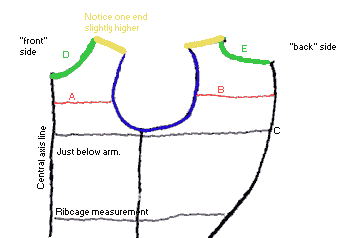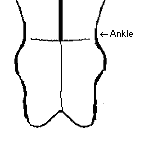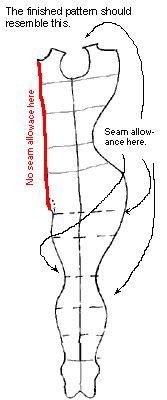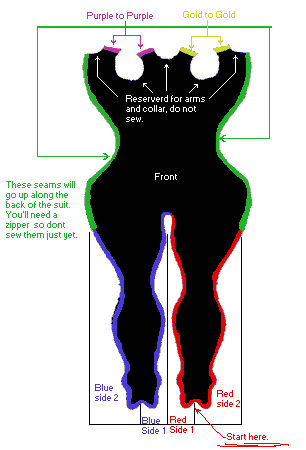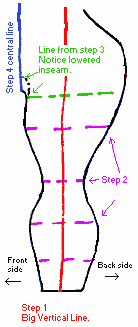
The main body of the suit includes everything from the feet up to the lower neck and shoulders. It is the largest pattern and fairly complicated but it should be done first because it'll be easier to accurately fit the other sections when this is complete.
Make the Pattern
1)It starts with a single long line. Measure from your ankle to your armpit, reduce for stretch and mark it. Now measure the distance from your ankle to your knee, your knee to your inseam, then the top of your pelvis, then to the waist. Remember to reduce each measurement by the same percentage as the first. I'll refer to this as the big vertical line. From this line you can draw all horizontal lines perpendicular (at a right angle) .
2)Take round measurements of your ankle, calf, knee, thigh, and any other relevant measurement on your leg. For now stay below the thigh. Also don't worry about the foot, it comes later. Mark them each at right angles with a line centered on the first line you drew in their appropriate position on the big vertical line. Once again remember to reduce by percentage.
3)Measure the inseam and mark it across. After this the pattern's getting not-so-symetrical so you choose a front side and a back. First lower the inseam slightly if your a woman and even more for a guy. If it's too tight around the crotch the suit will ride up and/or squeeze you in a baaad way. Now mark it with a curve away from the big vertical line toward the "front" side.
4) From the end of the inseam go straight up. Make sure this line is parallel to the big vertical line. It will go all the way up to the bottom of your neck. This is the central axis line of the costume.
5)Using the location of the pelvis determined in step one measure your pelvis and mark it from the central axis line not centered on the big vertical line. Since we're off the leg and on to the torso this and all following horizontal/round measurements must be divided by 2 before being reduced by the percentage. All torso measurements are also drawn from the central line not centered on the big vertical line.
Now we mark any pattern lines (black in the 1st diagram) we havn't so far. Just connect each round (horizontal) measurement to the next with smooth, flowing lines. Make sure everything below the thigh is symetrical. If you have one, use a flexible ruler. If not try tracing paper or cut out templates.
You should have marked the groin area in step 3, if not remeber to curve it so it comes together a bit like an arch when you make a symetrical transfer.
When connecting the inseam to the pelvis on the "back" side of the pattern you have to allow some extra space for your rear. First draw a horizontal line from the adjusted inseam (like the green line in the diagram). Now measure the distance from directly below your crotch to the very base of your spine. The curve from the adjusted inseam line to the pelvis line should be just slightly shorter than that. If it's far too small bubble the curve out a little.
The pattern will look unusually full in the hips, but that's okay, it should. The pelvis is where leg and torso meet and two seams become one so this actually accomidates the pelvis' contours in the pattern.
